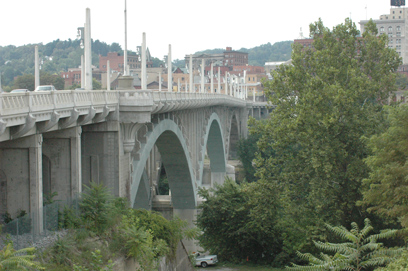
By the 1920s, with advances in steel and reinforced concrete building materials and plans designed by highway engineers, bridge building returned to custom-made
structures. One of the most impressive was located in Fairmont.
The appearance of the High Level Bridge that opened to traffic from downtown Fairmont to Palatine in 1921 was truly that of a “Million-Dollar Bridge.”
Hand-blown light fixtures, reportedly called “Fairmont Lamps” and never again reproduced, hung in pairs, one above another, from 16 north-side and 17 south-side
reinforced concrete poles, along with the lines for the trolley whose double tracks ran down the center. The bridge also included four 50-foot tapered flagpoles,
topped by gilded copper eagles, with bronze tablets and bases encasing four searchlights trained on the flags and finials.
Edged by seven-foot sidewalks and handsome parapet railings, the bridge’s deck was covered with brick paving blocks. Balconies topped the four-story “buildings”
within the bridge’s abutments, which included windows for light and ventilation. Stairwells between floors thus provided access from the bridge deck to Cleveland
Avenue and the B&O Railroad freight station on the west side of the Monongahela River and to Walter Street and the Monongahela Railway on the east.
At a time when neighboring Morgantown had no paved roads, the Jefferson Street bridge symbolized the national “better roads movement” championed by the US Bureau of
Roads to get rural America “out of the mud.” Crossing the river, rail lines and city streets, the 1266-foot structure on three graceful arch rings designed by
the Concrete Steel Engineering Company of New York and built by the John F. Casey Company of Pittsburgh was one of the earliest reinforced concrete arch bridges in the
country, a significant factor in its current listing on the National Register of Historic Places.
Readying West Virginia’s largest reinforced concrete arch bridge for its second century was the state’s most costly historic restoration. Designed by consultant Howard,
Needles, Tammen and Bergendoff and built by Mosites Construction Company of Pittsburgh under a $23.5 million contract awarded in March 1998 that included $6 million in
discretionary federal aid as well as normal federal and state bridge funding, the restoration matched as closely as possible the historic structure’s original appearance.
While the river piers needed only cosmetic repairs, the bridge on Marion County 19/73 east of US 19 was torn down to its three arch rings and piers and restored with
precast, pre-stressed concrete, including an overlay of pneumatically applied mortar on the arch rings.
Now providing four 10-foot lanes with seven-foot sidewalks on either side, the bridge includes parapet railings duplicating the originals and 33 concrete lighting
poles whose modern high-pressure sodium pendant light fixtures resemble those of the 1920s period. Restoration of the original flagpoles required “catalog model”
eagles. Although the windows of the abutment buildings have been restored and the former “balconies” converted to observation areas, safety reasons prevent public access
to the buildings and their stairwells.
In 2001 the state legislature named the structure for deceased US Congressman Robert H. Mollohan, a former area resident.